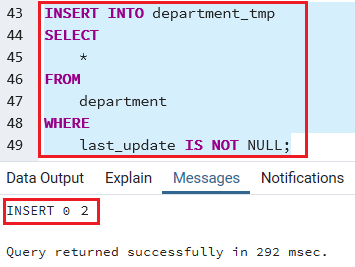

- Postgresql insert trigger how to#
- Postgresql insert trigger update#
- Postgresql insert trigger full#
- Postgresql insert trigger software#
- Postgresql insert trigger code#
Postgres Trigger Example #1: Creating a Time ClockĪ time clock records when an employee comes and leaves from work and calculates his/her total hours worked.
Postgresql insert trigger code#
Separating the trigger from the code it runs creates cleaner code and allows multiple triggers to execute the same code. In Postgres, is placed in a function and separated from the trigger. If you specified FOR EACH STATEMENT, then it would only run once.Īnd of course we can't forget the actual code to run when the trigger is activated. If you specify FOR EACH ROW in the trigger, then the trigger will run 5 times.
Postgresql insert trigger update#
Let's say you run a single UPDATE statement that changes 5 rows in a table. Effect of the triggerĪ trigger can run either per row, or per statement. If you need to be sure the event actually is going to occur, AFTER is ideal. If you want to block an event like an INSERT, you will want to run BEFORE.

Trigger BEFORE or AFTERĪ trigger can run either BEFORE or AFTER an event. If you don't include this list, updating any column will activate it. If UPDATE was one of the listed events, you can pass in a list of columns that should activate the trigger. Here are some examples of different events that can activate a trigger:Ī database trigger can also list more than one of these events. Here are the components to creating a trigger for your database:ĭatabase triggers will monitor tables for specific events.
Postgresql insert trigger how to#
How to Create a SQL Trigger - Postgres Syntax They are as one, in perfect SQL matrimony. Since the event and the trigger function are all part of one atomic transaction, you know with absolute certainty that the trigger will fire if the event fires. Natural atomicity is another desirable feature bundled with triggers. If the logic is implemented on multiple application servers, you can no longer expect a clean, definitive change in behavior. The SQL server acts as a single point of truth. If you had a business requirement to multiply an incoming number by 10, and you wanted to revise this logic to multiply the number by 20, changing the logic in SQL would guarantee that every piece of data from that exact deploy time on would be affected by the new logic. Separating business logicĬoding critical business logic within the application code also presents problems when the business logic is updated. Alternate solutions like Django's model hooks may fail if you have other application servers or users accessing the database who aren't aware of the specific business logic coded in your application. In some other engines like MySQL, the code block is a part of and inside the trigger.īefore I discuss what the different event types are and the specific syntax for creating a trigger, why would you want to use a database trigger? Advantages of using SQL Triggers Maintaining data integrityĭatabase triggers have a variety of uses and are an excellent tool to marshal strict data integrity. In Postgres, you delineate the code to run by creating a function whose return type is trigger. SQL Triggers, also called Database Triggers, allow you to tell your SQL engine (for these examples, Postgres) to run a piece of code when an event happens, or even before the event.

Postgresql insert trigger full#
Jonathan came home one day frustrated by a database full of convoluted SQL triggers.
Postgresql insert trigger software#
My brother, Jonathan, had just begun his software career at a startup. I was 12 years old when I first heard about SQL triggers.


 0 kommentar(er)
0 kommentar(er)
